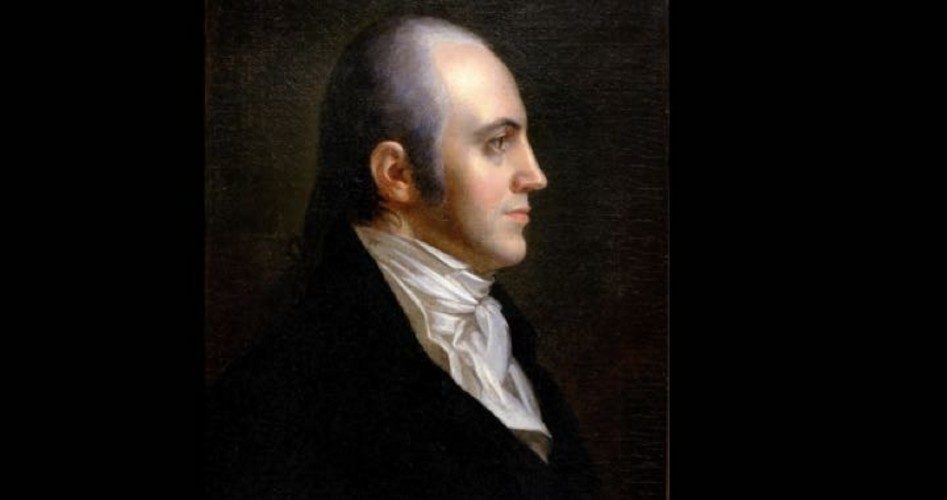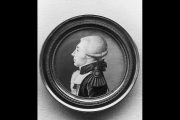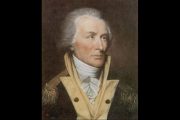
“I consider Burr as a man to be shunned … an unprincipled adventurer.”
James Monroe to James Madison, August 5, 1795
May 22, 1807 marks the 211th anniversary of the indictment of Aaron Burr by a grand jury on charges of treason against the United States of America.
Given that nearly every day in 2018 several mainstream news outlets promote reasons why President Donald Trump should be tried for treason, the story of Aaron Burr, himself once a very popular politician, takes on added significance. Add to that Burr’s prominent role in the monster musical Hamilton, and this story deserves re-evaluation.
Aaron Burr, a hero of the War for Independence, former vice president of the United States, and famous killer of Alexander Hamilton, became disaffected with the federal government. It began six years before his arrest when he was denied the presidency by the House of Representatives.
After he finished equal to Thomas Jefferson in the delegate count in the electoral college (each received 73 electoral votes), the House of Representatives was required to fulfill its constitutional role of tie-breaker. After 36 attempts to break the tie, on February 17, 1801, the House finally declared Thomas Jefferson the winner by one vote, making Burr his vice president according to Article 2 of the Constitution (this awkward arrangement was altered by the 12th Amendment).
In March 1805, after four troubled years filled with partisan in-fighting and blossoming distrust among Burr and many of the leaders of the day — including the famous collaborators Thomas Jefferson and James Madison — Burr left the Jefferson administration and began preparing for an armed expedition in the West that has come to be known as the Burr Conspiracy. This was the foolhardy mission that would see him tried for treason against the country that once heralded him a hero.
The origins of the conspiracy are found in the increasingly close relationship that developed between Aaron Burr and General James Wilkinson. The two Revolutionary War veterans served together in the Canadian theater, principally at Quebec during the winter of 1804-1805.
Over the years the two communicated via a secret code, a cipher that was apparently invented by General Wilkinson. Already by 1804 Wilkinson was notorious for being a rabble-rouser, having advocated for a separate republic to be established in the west, independent of the new nation built along the Atlantic seaboard.
Upon departing the banks of the Potomac, the former vice president struck out for a tour of the western territories. His first stop was Philadelphia in March of 1805, where he secured an interview with Anthony Merry, the British ambassador to the United States.
Merry reported details of his conversation in a letter to London, wherein he wrote that Burr had mentioned to him that “the inhabitants of Louisiana seem determined to render themselves independent of the United States” and that they were hindered only by the necessity to obtain “an assurance of protection and assistance from some foreign power.”
After attempting to recruit England into the conspiracy, Burr moved to Pittsburgh, where on April 29, 1805, he intended to rendezvous with his right-hand man, General Wilkinson. Fortunately for Burr and the nascent scheme to separate the Louisiana Territory from the young American Republic, Wilkinson was now the governor of that same territory.
However, Wilkinson failed to show up on the appointed day, so Burr set off down the Ohio River, leaving a message for the general in Pittsburgh.
Early the next month, Burr arrived at Blennerhassett’s Island, a 300-acre tract in the middle of the Ohio River belonging to an Irish immigrant named Harman Blennerhassett. Blennerhassett saluted Burr and asked him to stay for dinner. After the feast provided by his host, Burr began chatting up the wealthy Irishman, regaling him until nearly midnight with the details of his plot.
Burr then set out for Cincinnati.
Here, Burr conversed with one of the most enigmatic of all the players in the drama, former senator from Ohio and delegate to the Constitutional Convention of 1787 Jonathan Dayton. Tragically, Dayton soon would be dishonored by becoming one of Burr’s indicted co-conspirators, but years earlier he had earned the distinction of being the youngest man to sign the Constitution.
Satisfied with the results of his meeting with Dayton, Burr traveled to Louisville, disembarking there and setting off on foot for Nashville, where he would be an honored guest at the Hermitage — home of Andrew Jackson.
After bidding goodbye to Old Hickory, Burr finally met up with General Wilkinson at an old fort in southern Illinois. Here Burr procured from Wilkinson “an elegant barge, sails, colors, ten oars, with a sergeant and ten able, faithful hands,” and perhaps just as useful to the successful completion of the goal, Wilkinson provided Burr with a letter of introduction to a coterie of powerful associates in New Orleans, the city that would serve as the epicenter for the execution of the Burr Conspiracy.
Just when it seemed as if Burr was on the precipice of achieving his goal of separating much of the West from the United States and establishing himself as some sort of governor acting under the direction of the Spanish crown, the conspiracy began to unravel.
Inexplicably, General Wilkinson began to extricate himself from Burr’s web of treachery. Upon receipt of a coded message from Burr, Wilkinson ordered the militia to march into the Mississippi River valley and placed troops in New Orleans on alert, fearing an attack by Burr and his army.
Wilkinson then packaged an apparently condemning ciphered letter (propitiously decoded by Wilkinson himself), along with a similar missive penned by alleged co-conspirator Jonathan Dayton, and mailed them to President Thomas Jefferson. The Burr letter became an incriminating brick of evidence in what would become the wall of proof of the existence of the Burr Conspiracy.
President Jefferson responded to Wilkinson’s letter by issuing an order urging the armed forces and other associated government officials to devote themselves to “searching out and bringing to condign punishment all persons engaged or concerned in such enterprise.”
In order to uncover the details of the conspiracy supposedly concocted by his erstwhile rival and vice president, Jefferson sent an agent of the State Department to investigate the matter. After visits to Blennerhassett Island — where he tricked the owner into divulging the details known to him — the agent (surnamed Graham) traveled to the capital of Ohio and compelled the governor to deploy a detachment of the militia to seize boats scheduled to be delivered to Burr.
As Burr and his battalion were encamped across the river from Natchez, a contingent of about 30 militia men arrested Burr and took him to Mississippi, where he was to be interrogated by the territorial governor.
After the meeting, Burr surrendered himself.
After listening to the evidence presented against the accused, the first grand jury to hear the evidence against Aaron Burr refused to indict him. Members of the grand jury even suggested that Burr’s arrest was an unconstitutional usurpation of police power by the federal government and was nothing more than a cause for “the enemies of our glorious Constitution to rejoice.” Burr was released on his own recognizance, and he disguised himself as a riverboat worker and disappeared across the Mississippi River.
After receiving a report from Graham, Jefferson issued a new warrant, and Burr was arrested in what is today the state of Alabama and was taken by a military guard a thousand miles on horseback to Richmond, Virginia, where he was indicted — by the fourth grand jury to hear the evidence of treason — and subsequently tried. The trial featured the participation of a who’s who of the Founding Generation, including Edmund Randolph, Luther Martin, and John Marshall.
Burr was acquitted of treason, but his political career was destroyed. He left for Europe in a self-imposed exile, and later returned to the United States under a different name and deeply in debt. Burr died September 14, 1836.



